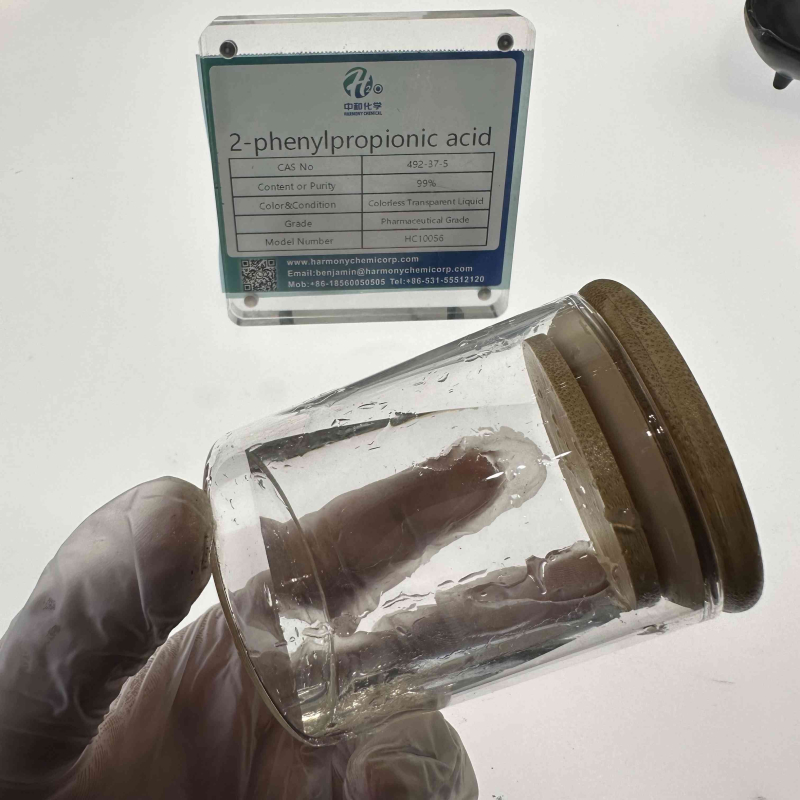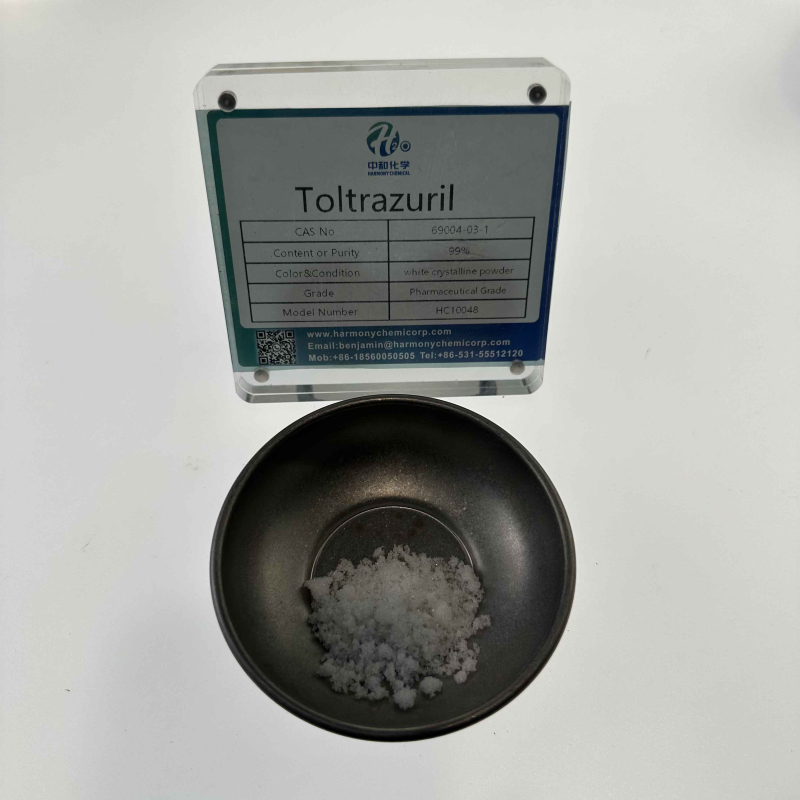nameL-carnitineCAS NO541-15-1Molecular formulaC7H15NO3molecular weight161.2melting point197-212 °C(boiling point287.5°CStorage conditionsStore below +30°C.formCrystals or Crystalline PowdercolourWhitepH value6.5-8.5 (50g/l, H2O)
Contact Now
nameL-ProlinamideCAS NO7531-52-4Molecular formulaC5H10N2Omelting point95-97 °Cboiling point213.66°C (rough estimate)refractivity1.4720 (estimate)Storage conditionsKeep in dark place,Inert atmosphere,Room temperaturesolubilityChloroform (Slightly), Methanol (Slightly)formPowder or GranulescolourWhite
Contact Now
nameAlbendazoleCAS NO54965-21-8Molecular formulaC12H15N3O2Smolecular weight265.33melting point208-210 °Cdensity1.2561Storage conditions2-8°CformneatcolourWhite to Off-WhiteSOLUBLE0.75mg/L(209 ºC)
Contact Now
Melting point>300 ° C (lit.)Density1.25Vapor pressure0Paat25 ℃Storage conditionsStorebelow+30 ° CSolubility450g/lFormCrystallinePowderChemicalbookAcidity coefficient (pKa)12.5 [at 20 ℃]ColorWhite to most whitePH value11.7 (110g/l, H2O, 20 ℃)Water solubility450g/L (20 º C)Guanidine carbonate is a chemical substance with the molecular system C2H10N6H2CO3.
Contact Now
CAS NO104-47-2Molecular formulaC9H9NOmolecular weight147.17melting point8 °Cboiling point286-287 °Cdensity1.085 g/mL at 25 °CStorage conditionsSealed in dry,Room TemperatureformLiquidcolourClear colorless to slightly yellowpH value4.5 (100g/l, H2O, 20℃)suspension
Contact Now
melting point86-88 °C(lit.)Storage conditions2-8°CformPowdercolourWhite to off-whitepH value4.0 to 6.5(50g/L, 25 ℃)SOLUBLEsolubleCAS NO1670-14-0Molecular formulaC7H9ClN2molecular weight156.61EINECS number216-795-4
Contact Now
Prilocaine is an amide type close by anesthetic. Its anesthetic depth and pace are similar to Lidocaine, alternatively its size is prolonged and its vasodilation have an impact on is weak. The toxicity is limit than lidocaine. Clinically used for close by anesthesia, specially fantastic for victims who hold away from the utilization of adrenaline.namePrilocaineCAS NO721-50-6Molecular formulaC13H20N2Omelting point37-38°boiling pointbp0.1 159-162°density1.0117 (rough estimate)refractivitynD20 1.5298Storage conditions2-8°CformCrystalline powderSOLUBLE6.169g/L(25 ºC)
Contact Now
CAS NO492-37-5Boiling point260-262 °CDensity1.1 g/mL at 25 °Cflash point>230 °FStorage conditionsSealed in dry,Room TemperatureFormLiquidColourClear pale yellow to yellowpH value3 (5g/l, H2O, 20℃)SOLUBLE10 g/L (20 ºC)Molecular formulaC9H10O2
Contact Now
English nameAmmonium Zirconium HexafluorideCAS16919-31-6Molecular formula(NH4)2.ZrF6Molecular weight241.29Density1.15g/mLat 25°C(lit.)Water-solubility287.7g/L at 20℃Storage conditionsRoom TempratureAppearanceWhite crystalsmolecular structure:
Contact Now
Bisphenol A polyoxyethylene ether is a chemical with the chemical system C15H16O2. (C2H4O) n.Boiling point350 ℃ [at one hundred and one 325 Pa]Density1.18 g/mL at 25 ° CVapor pressure0Pa at 25 ℃Refractive indexn20/D 1.552Flash point230 ° FWater solubility697mg/L at 20 ℃
Contact Now
Melting point>300 ° C (lit.)Storage conditionsnorestrictionsSolubility H2Osoluble25mg/mLFormPowderColor index45400ColorWhite to light creamPH value5.5-7.5 (100g/l, H2O, 20 ℃)PH cost vary of acid-base indicator discoloration5.5-7.5 (100g/l, H2O, 20 ° C)water solubilitySoluble in waterSodium dodecyl sulfonate is a broadly used anionic surfactant, which is a white or barely yellow powder with houses such as decontamination, wetting, foaming, emulsification, dispersion, coagulation, degreasing and deinking.
Contact Now
Melting Point180-185 °C(lit.)Density1.18 g/mL at 25 °C(lit.)Refractivityn20/D 1.465Storage Conditionsroom tempSolubilityH2O: 6 M, clear, colorlessFormCrystalsColourWhite to slightly yellowPh Value4.5-5.5 (100g/l, H2O, 20℃)1. It can be used as an intermediate in medicine, pesticides, dyes, and different natural synthesis.
Contact Now
AppearanceAmber obvious liquidSolid content% ≥ 40.0Density (20 ℃)g/cm3 ≥ 1.20PH fee (1% aqueous solution)9.0-11.0Solubility15gPolyaspartic acid (PASP) belongs to a crew of polyamino acids. Polyaspartic acid is susceptible to breakage due to the motion of microorganisms, fungi, and different factors, ensuing in the degradation of environmentally pleasant ammonia, carbon dioxide, and water. Therefore, polyaspartic acid has a extensive vary of uses.
Contact Now
CAS NO153-94-6Molecular formulaC11H12N2O2melting point282-285 °Cboiling point342.72°CStorage conditionsKeep in dark place,Inert atmosphere,Room temperatureformPowdercolourWhite to slightly yellowSOLUBLE11 g/L (20 ºC)stabilityStable. Incompatible with oxidizing agents.Characteristics and Functions D-neneneba tryptophan, as a non protein energetic amino acid, has specific physiological properties. It can be used as a non dietary sweetener, feed additive, and plant increase agent in the meals and feed enterprise and agriculture.
Contact Now
nameAcetophenoneCAS NO98-86-2Molecular formulaC8H8Omolecular weight120.15melting point19-20 °Cboiling point202 °Cflash point180 °FStorage conditionsStore below +30°C.formLiquidcolourClear colorless to light yellow
Contact Now
nameMK-4827 (tosylate)CAS NO1038915-73-9Molecular formulaC26H28N4O4Smolecular weightmolecular weightmelting point>142oC (dec.)Storage conditions-20°C FreezersolubilityMethanol (Slightly)formformcolourOff-White to Pale Yellow
Contact Now
nameFlubendazoleCAS NO31430-15-6Molecular formulaC16H12FN3O3molecular weight313.28melting point290°CStorage conditions2-8°Cdensity1.3720Acidity coefficient10.66±0.10formneatcolourWhite to Off-White
Contact Now
Zirconium acetate (liquid), a colorless obvious liquid organized by way of the response of zirconium oxychloride and sodium carbonate. Widely used in industries such as medicine, cosmetics, electronics, ceramics, paint, glass, etc.Density1.279g/mLat25 ° CFormliquidWater solubility931g/Lat20 ℃InchiKeyMFFVROSEPLMJAP-UHFFFFAOYSA-JCAS datalibrary 7585-20-8 (CASDataBaseReference)EPA Chemical InformationAceticacid, Zirconiumsalt (1:?) (7585-20-8)
Contact Now
Chemical factor structure mannequin of petroleum resin:The most commonly used petroleum resin manufacturing applications are C9 petroleum resin and C5 petroleum resin.C9 petroleum resinC9 petroleum resin mainly refers to a resinous substance formed via polymerization of olefins or cyclic olefins containing nine carbon atoms or copolymerization with aldehydes, fragrant hydrocarbons, terpene compounds, etc.C9 petroleum resin, also acknowledged as aromatic petroleum resin, can be divided into sorts such as hot polymer
Contact Now
Density1.13 [at 20 ℃]Vapor pressure0.317Paat25 ℃FormViscousLiquidColorGreenWater solubilityIn soluble in waterExposure limitNIOSH: IDLH10mg/m3; TWA0.015mg/m3Nickel naphthenate is an natural compound with the chemical formulation of C22H14NiO4. It is normally used as paint drier, timber preservative, water resistant agent for fabrics, insecticide and bactericide.
Contact Now
Polyvinylpyrrolidone, additionally recognised as PVP, is a polymer of ethylene pyrrolidone. Due to its one-of-a-kind ranges of polymerization, it can be divided into soluble PVP and insoluble PVPP (polyvinylpyrrolidone). The relative molecular weight of soluble PVP is 8000~10000, which can be used as a precipitant to precipitate with the aid of reacting with polyphenols. By the use of this method, there are without problems residual PVP in the wine.
Contact Now
nameAmitrazCAS NO33089-61-1Molecular formulaC19H23N3molecular weight293.41melting point86-87°Cboiling point425.25°C (rough estimate)density1.1280Storage conditionsSealed in dry,Store in freezer, under -20°CformPowder/SolidcolourWhite
Contact Now
Melting Point2-4 °C (lit.)Boiling Point90 °C (lit.)Density1.069 g/mL at 25 °C (lit.)Vapor Density3.1 (vs air)Vapor Pressure18 mm Hg ( 21.1 °C)Refractivityn20/D 1.368(lit.)Flash PointStore below +30°C.Although phosgene has excessive reactivity, its fairly poisonous and corrosive byproducts pose significant environmental strain and will progressively be phased out; DMC has a comparable nuclear response response center.
Contact Now
nameToltrazurilCAS NO69004-03-1Molecular formulaC18H14F3N3O4Smolecular weight425.38melting point194-196°Cdensity1.54±0.1 g/cm3(Predicted)Storage conditionsSealed in dry,Room TemperatureAcidity coefficient (pKa)Sealed in dry,Room Temperatureformneat
Contact Now





























